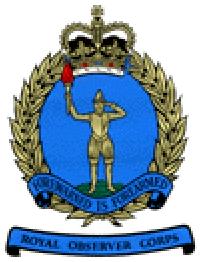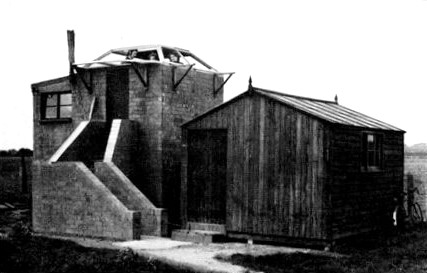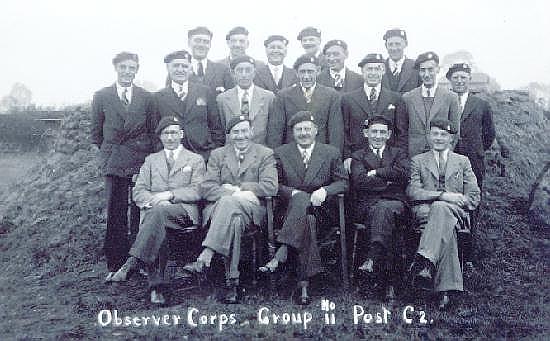|
Bourne at war A HISTORY OF THE ROYAL OBSERVER CORPS
The Observer Corps was formed in 1925 but its origins can be traced to the Metropolitan Observation Service of the First World War that reported on German Zeppelins attacking Britain, mainly London. In 1929 it was transferred from the War Office to the Air Ministry, a move that served to tie it to the Royal Air Force for the remainder of its active service. The corps served honourably throughout the Second World War, and following the end of the Battle of Britain King George VI awarded it the Royal prefix in 1941. Later that year, the Royal Observer Corps excelled itself by tracking the flight and performing the identification of the aircraft that brought Germany's Deputy Führer Rudolph Hess to Scotland in an attempt to seek a peace settlement with the British government. All except the full-time officers were volunteers who were provided with a uniform, a small retainer and a petrol allowance. But all agreed they also benefited from the satisfaction of doing an important job and from the comradeship of the service whose primary role was the recognition and identification of hostile aircraft and to warn our defences of what was approaching. The Observer Corps at Bourne began in February 1936 with the formation of No 11 Group that also included posts at Holbeach, Billingborough and Quadring Fen. Bourne was known by the codename Charlie 2 and initially had a crew of six men but in 1938, this number was increased to 13 and then 19 by early 1939. During that year, members took part in RAF manoeuvres when the post was continually manned for 72 hours, monitoring mock raids by low flying aircraft.
When the Second World War began in September 1939, Charlie 2 had no kind of shelter and so they built one themselves in the shape of the old blockhouses used in South Africa during the Boer War, a design suggested by one of the members who was a veteran of the campaign. The building off North Road was not completed when the winter set in and so a haystack cover was used as a protection against the weather. When the Germans began their intensive bombing raids on Britain in 1940, the crew were on alert, tracking aircraft on their way to Coventry, Birmingham and Leicester and during the London blitz, fires, flares and bomb blasts could plainly be seen on the skyline at night. By this time, the post was manned by a team of ten men comprising a chief observer, a leading observer and eight observers working in eight-hour shifts as and when necessary. Three such posts formed a cluster and two clusters made up a sector commanded by an Observer Officer. All had been given a thorough training in aircraft recognition and their task was to plot the direction of enemy planes through binoculars and report their progress by telephone to sector headquarters. There were three major incidents for Charlie 2 at this time. The first was at 1800 hrs one Sunday evening when a hostile plane flew directly over the post on a south east course at 1500 feet and let go 13 bombs which dropped approximately one mile away but the explosions were hardly heard by the men on duty and did little damage. The second incident was again on a Sunday, this time 4th May 1941 when they tracked a hostile aircraft flying west at 14,000 feet. Suddenly, there was a burst of cannon fire and the German plane was soon ablaze and commenced circling Bourne with various parts falling off as it went. At 6,000 feet, the aircraft's nose went down and with engines roaring and full out, it screamed to earth and crashed on the Butcher's Arms public house in Eastgate, resulting in the loss of ten lives. The third incident occurred when a German aircraft dropped several bombs 300 yards from the observation post in North Road and although the duty crew were shocked, none was injured. Later in the war, in 1944, several V I unmanned rockets, better known as flying bombs or doodlebugs, passed overhead and the information was swiftly sent on to the next sector. Later in the war, thousands of British and American bombers were tracked heading for missions over Germany and although there were manning difficulties at times, they managed to keep Charlie 2 fully crewed whenever there was an emergency.
The corps continued in existence when hostilities ended in 1945 but its role began to change and with the start of the cold war and the increasing threat of nuclear attack, in 1955 it was given the added responsibility of reporting nuclear bursts and monitoring fall-out and this necessitated the construction of 1,563 underground monitoring posts throughout Great Britain and Northern Ireland. There were 55 of them in Lincolnshire including one at Bourne that was opened in August 1961, replacing the old observation post on the north side of a field boundary 50 yards east of the A15 on the Morton side of Dyke village. One member later recalled: "You had to avoid the cow pats and needed a torch in winter." The Bourne post was built fifteen feet underground and equipped with sensitive instruments to register atomic bomb blasts and fall-out. The concrete walls were three feet thick and the surface protected by a layer of tar and brickwork. Access was by a heavy trapdoor and inside was a single small room containing three bunks with blankets, a table and cupboards containing enough food and water to last three men three days. A battery provided the power for the electric light and a telephone linked the post to the headquarters in Lincoln. The room also contained meteorological equipment and a radio in case the telephone line was cut together with the vital instruments needed to determine where a nuclear bomb had landed, how powerful it was and the strength of the radiation affecting the area. Aircraft recognition now took up only five per cent of the crew's time and there were frequent practices in tackling the new threat, notably in 1965 when observers were given tuition in recognising and handling fallout and again in 1971 when their capability came under scrutiny with a NATO exercise called Intex 71 in which the skills of the observers and the efficiency of their equipment was tested to the limit by obtaining and passing mock information around Europe that had been the target of a nuclear attack. The crew passed the test with flying colours. The observer posts at Bourne and in the rest of Lincolnshire closed in August 1991 and the official stand down came on Sunday 29th September. Nationwide, 870 posts became redundant together with 9,000 volunteers and 70 full-time officers. Women had been admitted since 1941 and three were serving at the Bourne post when it closed, Sue Glossop, Georgina Blundy and Glynis Kerr. Most of the posts that closed down reverted back to their original landowners or were put out to public tender and many were snapped up by cellular telephone operators because of their strategic positions on high ground. The Bourne post was eventually demolished and all surface features cleared away in March 1993. A disused telegraph pole and one concrete fence post on the field boundary are the only evidence that remain. Some of the memorabilia however has been preserved in the Heritage Centre at Baldock's Mill. See also The Eastgate plane crash Go to: Main Index Villages Index
|


